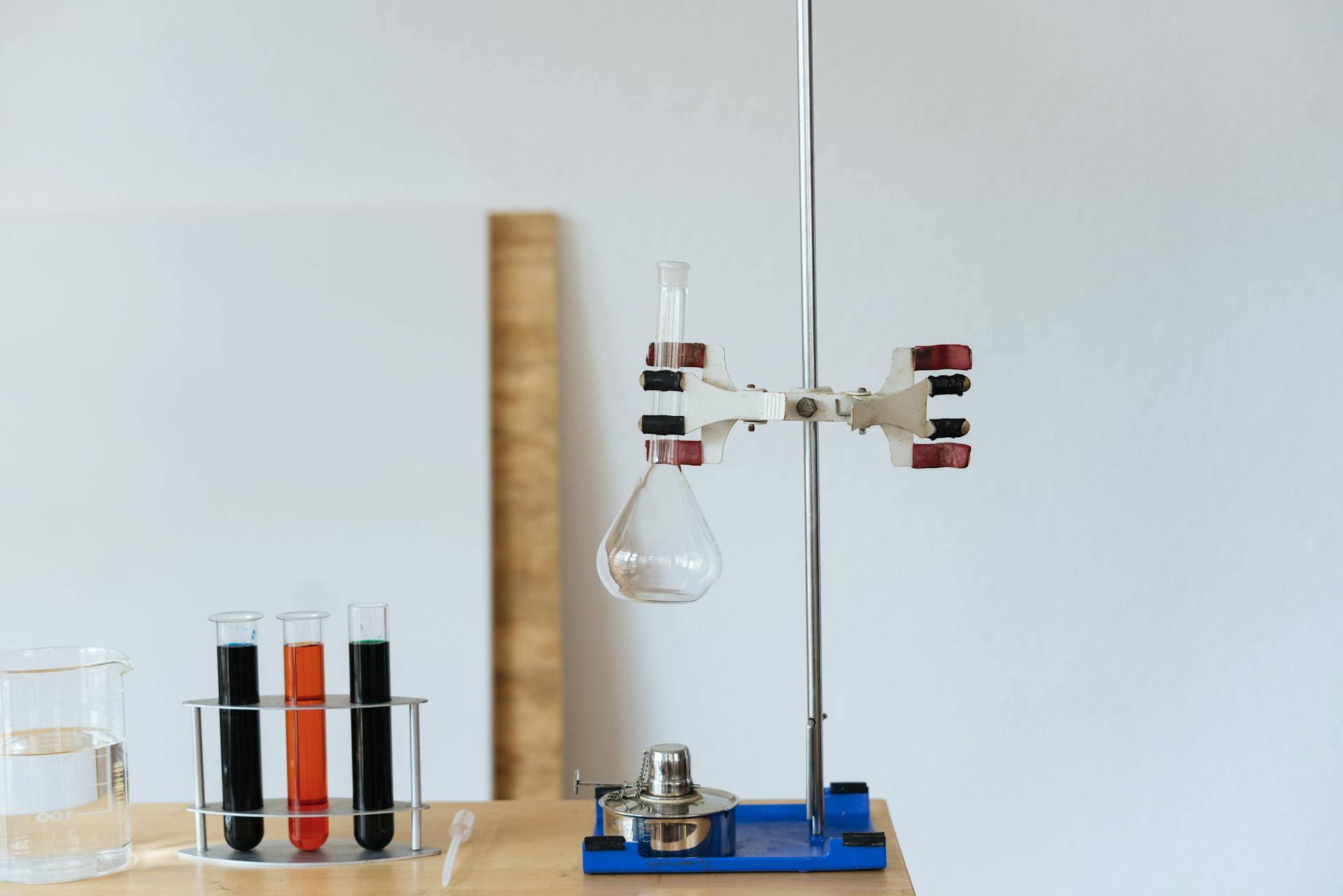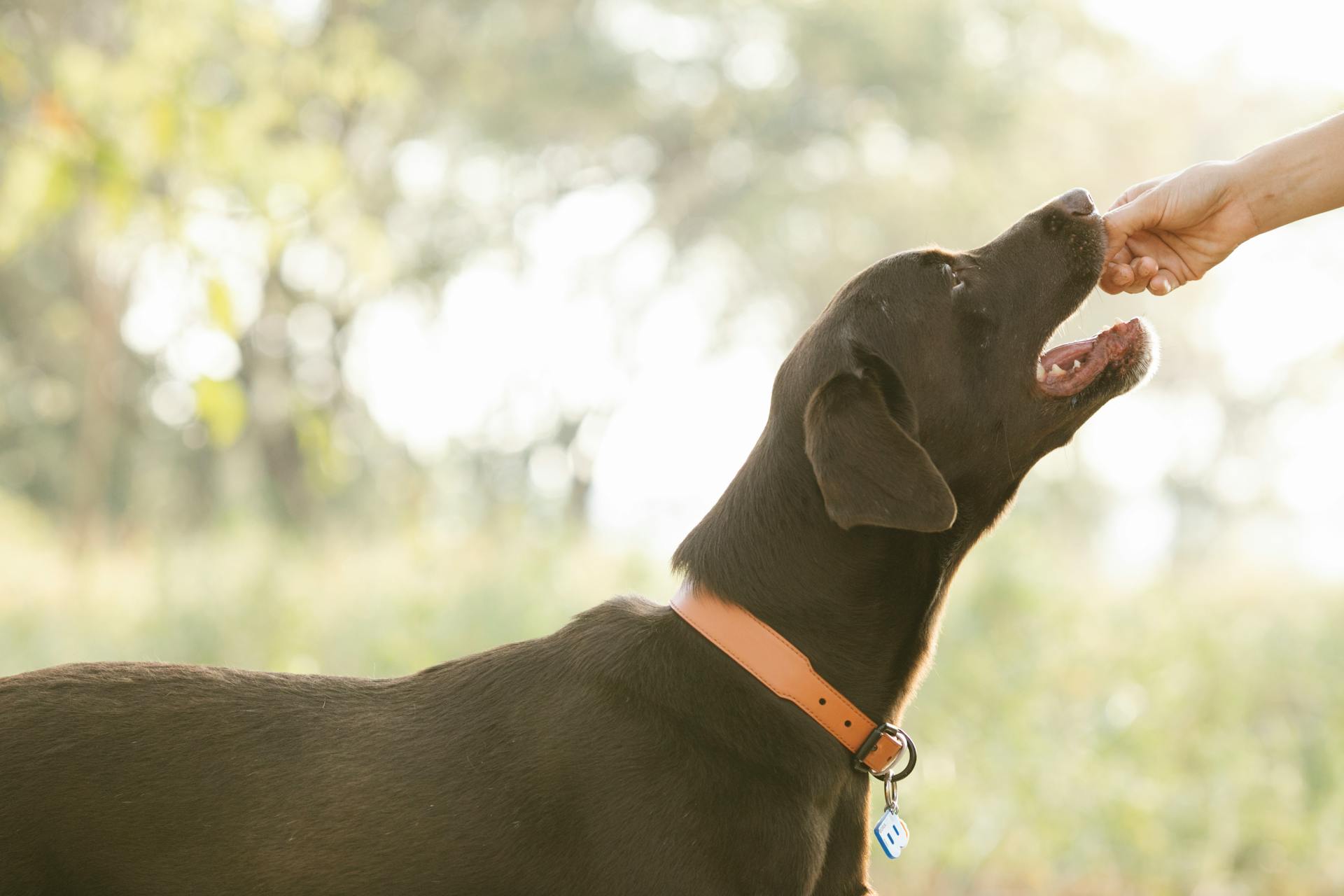
Tall Labrador Retrievers can grow up to 24.5 inches tall at the shoulder, making them a majestic breed. Their average weight is between 65-80 pounds, with males typically weighing more than females.
Labradors are prone to joint issues, so it's essential to feed them a balanced diet rich in glucosamine and chondroitin to support joint health. A well-balanced diet can also help prevent obesity, which is a common issue in Labradors.
Proper exercise is crucial for Tall Labrador Retrievers, as they need regular physical activity to maintain their muscle tone and prevent joint problems. Regular walks, playtime, and training sessions can help keep them happy and healthy.
Tall Labradors are also prone to bloat, so it's essential to feed them two to three smaller meals a day instead of one large meal to reduce the risk of bloat.
You might enjoy: Why Are Labradors so Friendly
Size and Growth
Labrador Retrievers are a popular breed, and one of the things that makes them so lovable is their size. Males can grow up to 24.5 inches tall.
Their weight can vary depending on their sex, with males typically weighing between 65 to 80 pounds and females weighing between 55 to 70 pounds.
Interestingly, during puppyhood, the weight difference between males and females is minimal, but it becomes more noticeable in adulthood. Adult males weigh around 72 pounds, while females weigh around 62.5 pounds.
In terms of height, males stand slightly taller, reaching an average of 23.5 inches at the shoulder, while females stand at 22.5 inches.
Here's a quick comparison of the average adult weights and heights for male and female Labradors:
Health and Conditions
As a tall Labrador Retriever owner, it's essential to be aware of the potential health issues that can affect your furry friend. Hip dysplasia is a common condition in Labradors, where the thigh bone doesn't fit properly into the hip socket, leading to pain and arthritis.
You can spot hip dysplasia if your dog limps, walks strangely, or stands awkwardly. Bringing your Labrador to the vet at two years old can help detect this condition early on.
Labradors are also prone to elbow dysplasia, a hereditary malformation of the elbow joint that can cause pain, lameness, and arthritis. Weight management and avoiding overexertion can help minimize symptoms.
Skin issues are another common problem in Labradors, with atopy causing skin to become itchy and leading to lesions if left untreated. Hot spots are a common skin infection that can be caused by bacteria, leading to itchiness and pain.
Labradors typically live for 10 to 13 years, but regular check-ups with your vet can help ensure they stay healthy and happy for as long as possible.
You might like: Dry Skin on Labradors
Temperament and Care
Tall Labrador Retrievers are known for their peaceful, social demeanor when meeting new people. They're friendly and outgoing, making them a joy to be around.
Their high energy levels mean they need regular exercise to stay physically and mentally fit. A daily routine that includes physical activity will keep them happy and healthy.
Tall Labradors are also incredibly eager to please, which makes them highly trainable with the right guidance and socialization. This means they can learn to control themselves around other people and dogs with proper training and socialization.
Suggestion: How Tall Do German Shepherds Get
Factors to Consider
As your puppy grows up, it's essential to consider various factors that can impact their development. Some of these factors can be influenced by you, while others are simply left to chance.
Genetics play a significant role in your dog's growth, and it's crucial to understand that some breeds grow faster or slower than others. This can affect their adult size and overall health.
Your puppy's diet and nutrition are critical in supporting their growth, and a balanced diet will help them reach their full potential. A puppy's growth plates are sensitive, so it's essential to feed them a nutrient-rich food to support bone development.
Exercise and playtime are also vital for your puppy's growth, as they help build strong muscles and bones. Regular physical activity can also reduce the risk of joint problems later in life.
Some factors, like your puppy's growth rate, are left to chance, and you can only provide a supportive environment for them to thrive.
Temperament
Labrador Retrievers are incredibly outgoing and energetic dogs, which makes them perfect for active families who love to participate in family activities.
Their friendly demeanor allows them to warm up to everyone they meet, including other dogs, making them a great addition to any household.
Labs are also very eager to please, which makes them highly trainable with the right guidance and socialization.
Regular exercise is essential to keep them physically fit, but it's also important to keep their minds active to prevent boredom and destructive behavior.
With the right training and socialization, Labrador Retrievers can learn to control themselves around other people and dogs, making them exceptional best friends for their owners.
Their loyalty extends over a lifetime, but it's essential to be ready for a committed friendship with your new Labrador Retriever.
Caring for a Retriever Dog
Caring for a Retriever Dog requires attention to their diet, which should be rich in protein and fat to maintain their energy levels. A Labrador Retriever needs a diet that includes high-quality protein sources such as chicken and fish.
Labrador Retrievers are prone to obesity, so it's essential to monitor their food intake and ensure they get regular exercise. Regular walks and playtime can help burn off excess calories and keep them healthy.
A Labrador Retriever's coat requires regular grooming to prevent matting and tangling, especially around the ears and tail. Brushing their coat daily can help prevent these issues.
Labrador Retrievers are highly social dogs that thrive on interaction with their human family members. They need plenty of attention and affection to stay happy and healthy.
On a similar theme: Labrador Retriever Coat Colour Genetics
Exercise and Training
American Labradors require more exercise due to their high energy levels, so be prepared to spend at least 60 minutes a day engaging them in physical activity.
They need an experienced master to train them, and early socialization is crucial for their social contact.
Both English and American labs are extremely intelligent and eager to please, making them a joy to train, but American labs might require a bit more patience and consistency.
They thrive on mental and physical stimulation, so don't be surprised if they're always ready for the next adventure.
Broaden your view: Why Are Labrador Retrievers so Popular
Labrador Exercise Needs
Labs require regular exercise, and it's essential to incorporate their favorite activities into their daily routine. They truly enjoy swimming and retrieving, so make sure to include these in their fitness regimen.
If they're not exercised regularly, they may start eating from the trash or exhibiting destructive behavior. This is a common issue that can be easily prevented with enough physical activity.
The entire family should take part in their favorite activities, such as playing fetch and catching the Frisbee, to keep them happy and engaged. This is a great way to bond with your Labrador and create lasting memories.
Training Differences
Training Differences are noticeable between American and English Labradors. American Labradors are considered hard to train and require an experienced master with skilled knowledge.
Both English and American Labradors are extremely intelligent and eager to please, making them a joy to train. However, due to their high energy, American Labs might require a bit more patience and consistency.
Curious to learn more? Check out: Are Labradors Easy to Train

You'll need to dedicate 60 minutes of exercise daily for both breeds. American Labradors have a lot of energy and are always ready for physical activity, making them more demanding.
English Labradors, on the other hand, have a relative show personality and are less demanding. They still require regular exercise, but it's a bit easier to manage their energy levels.
Both breeds love to go in the water and can help you retrieve things from the water, satisfying their bodies and minds.
You might enjoy: How Much Exercise Do Labrador Retrievers Need
Anatomy and Structure
Tall Labrador Retrievers are built for speed and agility, with a muscular build that allows them to cover ground quickly. They typically weigh between 65-80 pounds.
Their height is one of their most distinctive features, with males reaching up to 24.5 inches and females up to 23.5 inches. Their athletic build is due in part to their bone structure, which is made up of a combination of dense and hollow bones.
The Labrador Retriever's skeletal system is designed for movement and flexibility, allowing them to jump high and run fast. Their joints are also incredibly strong, capable of withstanding the impact of sudden stops and changes in direction.
Frequently Asked Questions
What is the bigger breed of Labrador?
The American Labrador is generally considered the larger breed, with a height range of 21.5 to 24.5 inches, compared to the British Labrador's 21.5 to 22.5 inches.
Why is my Labrador so big?
Labradors are prone to obesity due to a genetic predisposition that affects their ability to feel full after eating. This means they may overeat and gain weight more easily than other breeds.
Sources
- https://www.smokymtnlabrador.com/blog/an-english-labrador-vs-american-labrador
- https://www.thekennelclub.org.uk/breed-standards/gundog/retriever-labrador/
- https://www.caninejournal.com/labrador-retriever-growth-chart/
- https://www.petlandflorida.com/labrador-retriever-a-puppy-youll-forever-love/
- https://www.petplace.com/article/breed/labrador-retriever
Featured Images: pexels.com


